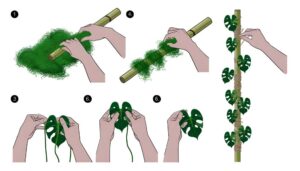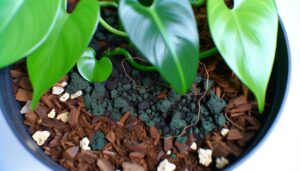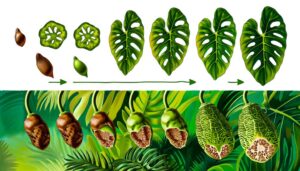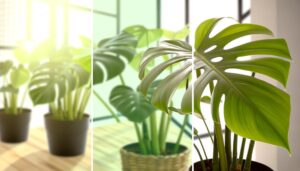Differences Between Monstera Xanadu and Monstera Deliciosa
You’ll notice significant differences between Monstera xanadu and Monstera deliciosa. Monstera xanadu features smaller, deeply lobed, pinnatifid leaves, maturing around 15-20 cm, and maintains a compact, bushy growth habit.
In contrast, Monstera deliciosa presents larger, fenestrated leaves up to 60-90 cm, climbing via aerial roots. While both thrive in bright, indirect light, Monstera deliciosa struggles more in low light.
Monstera xanadu requires well-draining soil, and Monstera deliciosa prefers slightly moist conditions. Xanadu’s compact form suits confined spaces; deliciosa is ideal for dramatic, tropical aesthetics.
Learn more about maintaining each species for healthy, thriving plants.
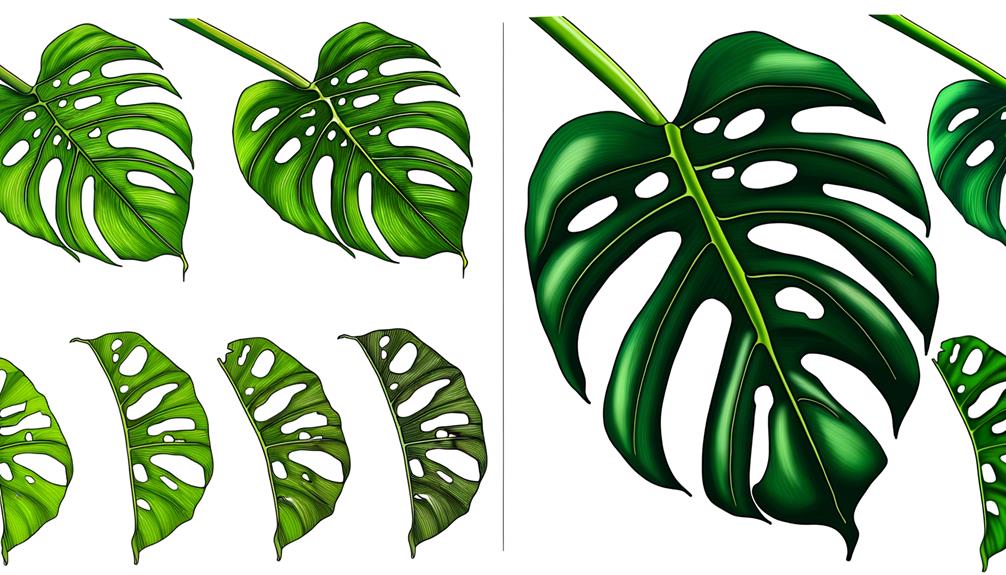
Key Takeaways
- Monstera xanadu has smaller, deeply lobed leaves, while Monstera deliciosa has larger, fenestrated leaves with natural perforations.
- Monstera xanadu grows compact and bushy, whereas Monstera deliciosa climbs and spreads via aerial roots.
- Monstera deliciosa’s leaves can reach 60 to 90 centimeters, creating a dramatic aesthetic; Monstera xanadu’s leaves are 15 to 20 centimeters.
- Monstera deliciosa requires support for vertical growth, ideal for living walls or trellises; Monstera xanadu adapts well to low light conditions.
- Monstera xanadu thrives in well-draining soil, while Monstera deliciosa prefers slightly moist soil for optimal health.
Monstera Xanadu vs Monstera Deliciosa: Differences in Appearance, Care & Growth
| Characteristic | Monstera Xanadu | Monstera Deliciosa |
|---|---|---|
| Leaf Shape | Smaller, lobed leaves with a more compact form. | Large, heart-shaped leaves with deep splits and holes. |
| Size | Grows more compact and bushy, typically around 3-5 feet tall. | Can grow much larger, climbing up to 10 feet or more indoors. |
| Growth Habit | Upright, clumping habit, does not climb or trail. | Climbs and spreads with aerial roots, requires support. |
| Fenestration (Leaf Holes) | No fenestration, leaves remain solid. | Fenestrations develop in mature leaves, iconic split appearance. |
| Light Requirements | Thrives in bright, indirect light but tolerates lower light. | Prefers bright, indirect light; can tolerate some direct sunlight. |
| Care Difficulty | Low-maintenance and beginner-friendly. | Slightly more care-intensive, especially as it grows larger. |
| Native Region | Native to Brazil, commonly cultivated as a houseplant. | Native to Central America, known for its dramatic tropical look. |
Leaf Shape
When comparing leaf shape, Monstera xanadu exhibits smaller, more deeply lobed leaves, while Monstera deliciosa features larger, fenestrated leaves with characteristic splits and holes.
You’ll notice that Monstera xanadu (Philodendron xanadu) has a dense arrangement of pinnatifid lobes, giving it a textured, almost feathery appearance.
In contrast, Monstera deliciosa leaves are known for their dramatic fenestrations—natural perforations—that develop as the plant matures, resulting in a more open, airy look. These fenestrations aren’t just for aesthetics; they’re believed to aid in wind resistance and water distribution.
Understanding these differences in leaf morphology is vital for proper identification and care, ensuring that each species thrives in its respective environment.
Leaf Size
In addition to their distinct shapes, the leaves of Monstera xanadu (Philodendron xanadu) are noticeably smaller in size compared to the expansive foliage of Monstera deliciosa. Monstera xanadu typically exhibits leaves that reach lengths of 15 to 20 centimeters, presenting a more compact appearance.
Conversely, Monstera deliciosa boasts much larger leaves, which can grow up to 60 to 90 centimeters in length under ideal conditions. The smaller leaf size of Monstera xanadu makes it more suitable for confined spaces, whereas Monstera deliciosa’s large, fenestrated leaves create a more dramatic, tropical aesthetic.
Understanding these differences helps you choose the right plant for your space and care requirements, ensuring best growth and visual appeal.
Growth Habit
When analyzing the growth habit of Monstera xanadu and Monstera deliciosa, you’ll notice distinct differences.
Monstera xanadu exhibits a bushy, compact growth, while Monstera deliciosa tends to climb and spread via aerial roots.
Additionally, the size at maturity varies considerably, with Monstera deliciosa reaching greater heights compared to the more contained structure of Monstera xanadu.
Leaf Shape Comparison
Monstera Xanadu, known scientifically as Thaumatophyllum xanadu, typically exhibits smaller, more compact leaves with deep lobes, while Monstera Deliciosa showcases larger, fenestrated leaves that develop distinctive perforations as they mature.
You’ll notice that Thaumatophyllum xanadu’s leaves maintain a consistent lobe structure, creating a more uniform, bushy appearance. In contrast, Monstera deliciosa’s leaves start solid and gradually develop fenestrations—holes and splits—that add a unique texture.
The fenestrations in Monstera deliciosa, also called Swiss cheese plant, enhance light penetration and reduce wind resistance in their native habitats. Thaumatophyllum xanadu’s lobes, on the other hand, provide a robust form without the need for such adaptations.
Both species’ leaf morphologies are optimized for their specific environmental conditions, reflecting their diverse evolutionary paths.
Climbing Vs. Bushy
Thaumatophyllum xanadu exhibits a bushy growth habit, forming dense clumps that remain relatively low to the ground, whereas Monstera deliciosa displays a climbing nature, using aerial roots to ascend vertical surfaces.
Xanadu’s growth pattern results in a compact, shrub-like appearance, characterized by multiple stems and a tendency to spread laterally. This makes it ideal for ground cover or as a focal point in a garden bed.
In contrast, Monstera deliciosa produces long, vining stems that actively seek support structures, such as trellises or tree trunks. Its aerial roots anchor into these surfaces, facilitating upward growth. This climbing habit allows Deliciosa to achieve greater vertical height, making it a striking choice for indoor spaces where vertical greenery is desired.
Size at Maturity
At maturity, Monstera deliciosa can reach impressive heights of up to 20 meters in its native tropical habitats, while Thaumatophyllum xanadu typically remains more compact, growing to around 1.5 meters in height.
- deliciosa exhibits a climbing growth habit, utilizing aerial roots to anchor itself to trees and other structures, which supports its substantial vertical growth. Conversely, T. xanadu demonstrates a bushy growth habit, forming dense clumps with a more horizontal spread.
The expansive size of M. deliciosa’s leaves, often exceeding 90 centimeters in length, contrasts with T. xanadu’s smaller, more uniform leaves, which grow to approximately 40 centimeters. Understanding these growth habits helps in selecting the appropriate plant for your space and care requirements.
Light Preferences
When considering light preferences, you’ll find that Monstera xanadu (Philodendron xanadu) and Monstera deliciosa (Monstera deliciosa) have distinct requirements.
Monstera xanadu thrives in bright, indirect light but can tolerate lower light conditions, while Monstera deliciosa prefers bright, indirect light and struggles with low light.
Direct sunlight can cause leaf burn in both species, so it’s essential to provide filtered light.
Ideal Light Conditions
Monstera Xanadu thrives in bright, indirect light, while Monstera Deliciosa prefers similar conditions but can also tolerate lower light levels better.
Place your Monstera Xanadu near east-facing windows where it can receive filtered sunlight, avoiding direct exposure that may scorch the leaves.
For Monstera Deliciosa, peak growth occurs under bright, indirect light, but it can adapt to areas with lower light intensity, thanks to its larger leaf surface area which aids in photosynthesis.
If you’re using artificial lighting, make sure Monstera Xanadu receives at least 12-14 hours of fluorescent or LED light daily.
Monstera Deliciosa, on the other hand, can manage with slightly fewer hours but still benefits from extended light exposure for robust growth.
Low Light Tolerance
Unlike Monstera Xanadu, which requires consistently bright, indirect light for ideal growth, Monstera deliciosa demonstrates a remarkable tolerance for lower light conditions, maintaining its health and vigor even in less than ideal lighting environments. This adaptability makes Monstera deliciosa (Monstera deliciosa) particularly suitable for indoor spaces with limited natural light.
In low light conditions, Monstera deliciosa will:
- Maintain foliage health: Leaves remain green and lush, though fenestrations may be fewer.
- Exhibit slower growth: Reduced photosynthesis results in slower but steady growth.
- Require less frequent watering: Lower light reduces water evaporation and uptake needs.
- Avoid direct sunlight stress: Minimizes risks of leaf scorch and sunburn.
Understanding these preferences allows you to optimize care for Monstera deliciosa in various lighting environments.
Direct Sunlight Impact
While Monstera deliciosa tolerates low light, exposing it to direct sunlight can cause leaf scorch and stunted growth, emphasizing the importance of filtered light for best health.
It thrives in bright, indirect light, where its large, fenestrated leaves (fenestrations are natural leaf holes) can develop fully.
Monstera xanadu (previously Philodendron xanadu), however, exhibits a higher tolerance to direct sunlight, but too much can still lead to sunburned foliage. To optimize photosynthesis without damaging chlorophyll, place Monstera xanadu in a spot with dappled sunlight or morning sun.
Both species benefit from light diffused through sheer curtains or placed a few feet from a bright window, ensuring they receive adequate light without harmful UV exposure.
Watering Needs
Effectively managing the watering needs of *Monstera xanadu* and *Monstera deliciosa* promotes their peak growth and prevents common issues like root rot. Both species demand attention to their specific hydration requirements.
- Frequency: Water *Monstera deliciosa* when the top 2-3 inches of soil are dry. *Monstera xanadu* prefers slightly more regular watering.
- Amount: Ensure complete saturation, allowing excess water to drain completely to prevent waterlogging.
- Humidity: Both plants thrive in high humidity. Mist the foliage or use a humidifier to maintain levels around 60-70%.
- Water Quality: Use distilled or rainwater to avoid chlorine and fluoride, which can lead to leaf browning.
Soil Requirements
Both *Monstera xanadu* and *Monstera deliciosa* flourish in well-draining, nutrient-rich soil that mimics their native tropical environments. You should use a mixture containing peat moss, perlite, and orchid bark to ensure peak aeration and moisture retention. The ideal pH range is slightly acidic to neutral, around 5.5 to 7.0. Avoid compacted soils, as they can lead to root rot due to poor drainage.
For *Monstera xanadu*, a high organic matter content is essential to support its dense foliage.
On the other hand, *Monstera deliciosa* benefits from a more aerated mix, given its extensive aerial roots.
Periodically check for soil compaction and amend with fresh components to maintain structure.
Regularly replenishing nutrients through organic fertilizers will promote vigorous growth.
Temperature Tolerance
When considering temperature tolerance, you’ll find that Monstera xanadu and Monstera deliciosa exhibit distinct preferences.
Monstera xanadu thrives in a favorable temperature range of 18-24°C, showing moderate cold weather resistance but limited heat tolerance.
In contrast, Monstera deliciosa prefers slightly warmer climates, with an ideal range of 20-30°C, and demonstrates greater heat tolerance but lower resilience to cold temperatures.
Ideal Temperature Range
Monstera Xanadu thrives in a temperature range of 65°F to 80°F (18°C to 27°C), whereas Monstera Deliciosa prefers slightly warmer conditions between 70°F and 85°F (21°C to 29°C). The best temperature range for these species optimizes their physiological processes to function efficiently.
To maintain ideal conditions for your Monstera plants:
- Monitor ambient temperature: Use a reliable thermometer to guarantee consistent warmth.
- Avoid temperature fluctuations: Sudden changes can stress the plant, affecting growth.
- Maintain humidity levels: Both species thrive in high humidity, around 60-80%.
- Provide indirect light: While temperature is essential, adequate light is also crucial for photosynthesis and overall health.
Cold Weather Resistance
Cold weather resistance varies greatly between Monstera xanadu and Monstera deliciosa, with the former enduring temperatures as low as 50°F (10°C) and the latter showing stress below 60°F (15°C).
Monstera xanadu, scientifically known as Philodendron xanadu, exhibits a robust tolerance to cooler climates, making it more suitable for regions with mild winters. In contrast, Monstera deliciosa, also called the Swiss cheese plant, is highly sensitive to temperature drops. Below 60°F (15°C), its metabolic processes slow down, leading to potential leaf damage and stunted growth.
You should monitor your Monstera deliciosa closely during colder months and consider bringing it indoors to maintain optimal conditions. Understanding these distinctions guarantees you provide the right care for both species.
Heat Tolerance Levels
Regarding heat tolerance, Philodendron xanadu can thrive in temperatures up to 90°F (32°C), while Monstera deliciosa begins to experience physiological stress above 85°F (29°C).
Understanding these limits is important for best care. Philodendron xanadu, with its robust foliage, can endure higher temperatures without significant damage. In contrast, Monstera deliciosa, known for its large fenestrated leaves, is more sensitive to heat stress.
To optimize both plants’ health, consider the following:
- Monitor Temperature: Use a reliable thermometer to track ambient conditions.
- Provide Shade: During peak heat, offer partial shade to reduce direct sunlight exposure.
- Increase Humidity: Utilize a humidifier to maintain ideal moisture levels.
- Water Appropriately: Adjust watering frequency to prevent desiccation.
These steps will help maintain your plants’ well-being during warmer months.
Humidity Levels
Ideal humidity levels play an important role in the health and growth of both Monstera adansonii (formerly known as Monstera Xanadu) and Monstera deliciosa. Maintaining a relative humidity of 60-80% is vital for Monstera adansonii, as this species thrives in moist environments. You should regularly mist its leaves or use a humidifier to mimic its native tropical habitat.
On the other hand, Monstera deliciosa, while also preferring high humidity, can tolerate slightly lower levels, around 50-60%. It’s less sensitive to fluctuations but still benefits from regular misting and placement near other plants to create a micro-humid environment. Consistently high humidity promotes lush foliage and robust growth in both species, preventing issues like browning leaf edges.
Pest Resistance
In addition to their specific humidity preferences, Monstera adansonii and Monstera deliciosa exhibit varying degrees of pest resistance, with Monstera deliciosa generally being more resilient to common pests like spider mites and aphids. Monstera deliciosa (Monstera deliciosa) often shows stronger resistance due to its robust leaf structure and natural pest-deterring compounds.
In contrast, Monstera adansonii (Monstera adansonii) tends to be more susceptible to infestations.
Here are four key pest management practices for both species:
- Regular Inspection: Frequently check leaves for signs of pests.
- Neem Oil Application: Use neem oil as a natural insecticide.
- Proper Ventilation: Maintain good airflow to reduce pest attraction.
- Clean Watering: Avoid overwatering to prevent creating a humid environment that attracts pests.
Understanding these differences helps you maintain healthier plants.
Propagation Methods
Propagating Monstera Xanadu and Monstera Deliciosa involves techniques like stem cuttings and air layering, which guarantee successful plant multiplication.
For stem cuttings, select a healthy section with at least one node and aerial root. Use a sterilized knife to make a clean cut below the node. Place the cutting in water or a well-draining soil mix, maintaining consistent moisture and indirect light.
For air layering, choose a stem with a node, make an incision, and wrap it with moist sphagnum moss. Secure it with plastic wrap, preserving humidity until roots develop. Once rooted, cut below the new root system and plant it.
Both methods ensure a high success rate for these species, Monstera deliciosa and Monstera xanadu.
Common Uses
After successful propagation, Monstera xanadu and Monstera deliciosa find widespread use in both indoor and outdoor settings due to their unique aesthetic appeal and air-purifying qualities. Their versatility and distinct leaf morphology make them favored choices for various applications.
You can utilize these plants as follows:
- Interior Decor: With their large, fenestrated leaves, Monstera deliciosa (Swiss Cheese Plant) adds a tropical touch to living spaces and offices.
- Outdoor Landscaping: Monstera xanadu, with its compact growth habit, is ideal for garden borders and shaded outdoor areas.
- Air Purification: Both species are known to improve indoor air quality by filtering out pollutants, as documented in studies on phytoremediation.
- Vertical Gardens: Employ Monstera deliciosa for creating living walls or trellises, leveraging their natural climbing abilities.
Conclusion
To sum up, you’ve seen that Monstera xanadu and Monstera deliciosa each bring something unique to the table. From their distinct leaf shapes and sizes to their specific light, water, and humidity needs, these plants cater to different environments and preferences.
Their propagation methods and uses also vary, making each suitable for different settings. By knowing these differences, you’ll be well-prepared to keep your plants thriving, ensuring they don’t become ‘fish out of water’ in their new homes.

